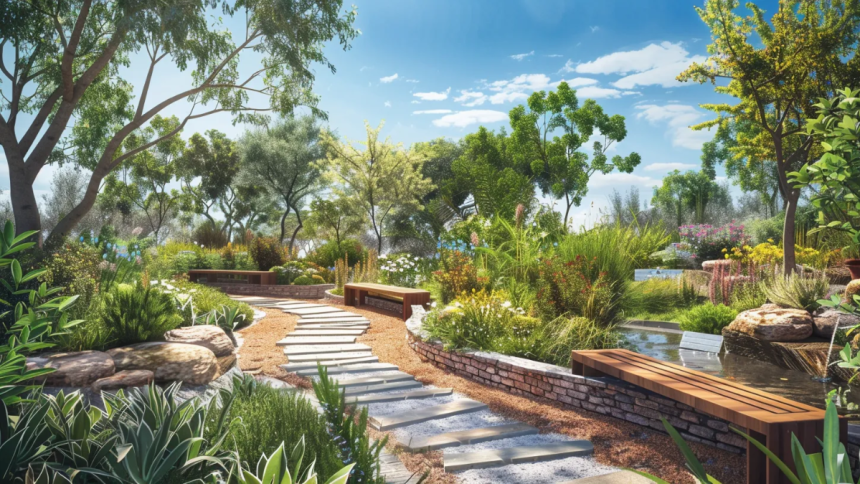Every beautiful outdoor space has one thing in common: a structure beneath the surface that makes it all work.
It’s easy to be impressed by color, texture, and curb appeal. A manicured lawn, flowering shrubs, and stylish pavers may capture attention, but it’s the unseen strategy behind those features that determines how well they function—and how long they last.
Thoughtful landscaping isn’t just about what’s above ground. It’s also about what holds everything in place, channels water efficiently, and maintains the balance between design and durability. And in this realm, retaining walls play a silent but essential role.
They’re not always the star of the show. But when done right, they allow everything else to perform.
Behind Every Landscape Is a Blueprint
Most people think of landscaping as planting and decorating. In reality, it’s part engineering, part architecture, and part environmental science. It’s about creating spaces that don’t just look good, but operate well over time.
A sloped backyard, for example, isn’t just a visual challenge. It’s a drainage issue, a stability issue, and a design opportunity—if handled correctly. A well-placed retaining wall turns that slope into a multi-tiered garden, a seating area, or a functional terrace.
Without it, the same slope becomes a water hazard or erosion risk.
The difference? Planning. Good design always begins with problem-solving.
Landscapes That Respond to the Environment
Landscaping should never fight nature—it should respond to it. Whether your property deals with heavy rain, harsh sun, or poor soil retention, the best outdoor solutions work with the environment’s natural behaviors.
Retaining walls are one of the most effective ways to adapt. They redirect water, break up steep grades, and provide level areas where none existed before. In some cases, they’re the only way to unlock usable outdoor square footage.
That’s not just valuable from a design standpoint—it’s essential from a longevity perspective. A yard that works with its environment lasts longer, looks better, and costs less to maintain.
More Than a Barrier: Retaining Walls as Design Features
Retaining walls are often introduced as functional necessities, but their value goes beyond reinforcement. They can shape the entire aesthetic of a property—adding height, depth, and visual rhythm to otherwise flat or chaotic spaces.
Built from stone, block, timber, or concrete, these walls offer opportunities to contrast textures, define zones, and introduce natural seating or raised garden beds. When integrated with lighting, planting, or pathways, they blur the line between structural necessity and design elegance.
Done well, a retaining wall doesn’t look like a solution—it looks like it was always meant to be there.
Durability That Doesn’t Compromise Style
Outdoor design is unique in that it must blend form and function under constant exposure to the elements. Retaining walls, when constructed properly, offer rare stability in a constantly shifting outdoor environment.
Rain, temperature changes, and ground movement can all take a toll on a yard. But a professionally designed retaining wall absorbs those pressures, protecting surrounding features from damage.
This durability also opens the door to more ambitious designs. Want to incorporate tiered gardens, fire pit terraces, or elevated patios? Retaining walls make those ideas structurally possible—without compromising the visual outcome.
Smart Design Saves Money in the Long Run
Initial landscaping investments often focus on the visible. But over time, the costs of neglecting structural elements become clear.
Poor drainage leads to plant loss. Soil erosion undermines hardscapes. Unstable slopes require constant patching. Retaining walls, though initially an added cost, often prevent these issues entirely.
By investing in infrastructure, property owners avoid repeat repairs, wasted labor, and design limitations. It’s a principle that guides professionals like K-ler Landworks—building with intention so clients don’t pay twice for short-term fixes.
A Landscape That Evolves With You
Great outdoor design isn’t static. It grows with the people who use it.
Families expand. Hobbies shift. Needs evolve. The patio that hosted dinners may become a yoga space. A sandbox may give way to a raised herb garden. But the foundational structures—the terraces, the grade-level changes, the walls—remain.
This adaptability is one of the quiet advantages of well-executed landscaping. Retaining walls provide a framework for flexible use. They make it easier to reimagine spaces without starting from scratch.
Your landscape becomes a system, not just a setting.
Good Landscaping Is Invisible Until It Isn’t
Think about the best outdoor spaces you’ve visited. Chances are, you didn’t immediately notice the retaining walls, the grading, or the drainage paths. You noticed how the space made you feel. Relaxed. Organized. Inspired.
That’s the hallmark of thoughtful landscaping—it disappears into the experience.
But when it’s missing, its absence is obvious. Uneven surfaces. Washed-out mulch. Water pooling. Lost plants. These are signs of design that looks nice but wasn’t built to last.
Retaining walls, though often quiet, prevent those failures. They hold everything in place so beauty can emerge.
Designing With Tomorrow in Mind
As more homeowners and property managers consider sustainability and resilience, the value of foundational landscape elements becomes even more clear.
Strong design doesn’t just serve one season—it serves generations. It reduces waste. It limits disruption. It allows outdoor spaces to thrive with less intervention.
Retaining walls exemplify this approach. Built with long-term performance in mind, they enable sustainable landscaping practices—from water-efficient plantings to durable surface materials.
When done right, they outlast trends. They’re built not just for the now, but for the next.
Final Thought: Stability Is Style
In an age of instant upgrades and superficial overhauls, the best outdoor spaces are those that hold steady. That work quietly. That make room for change without falling apart.
Retaining walls are more than just back-end supports in the world of landscaping. They are a symbol of smart design—calculated, quiet, and incredibly effective.
And when paired with a full-scope strategy from experienced landscapers they become the foundation of a landscape that works hard without ever looking like it had to try.
Because true style isn’t just what you see. It’s what holds everything together.
Lynn Martelli is an editor at Readability. She received her MFA in Creative Writing from Antioch University and has worked as an editor for over 10 years. Lynn has edited a wide variety of books, including fiction, non-fiction, memoirs, and more. In her free time, Lynn enjoys reading, writing, and spending time with her family and friends.















